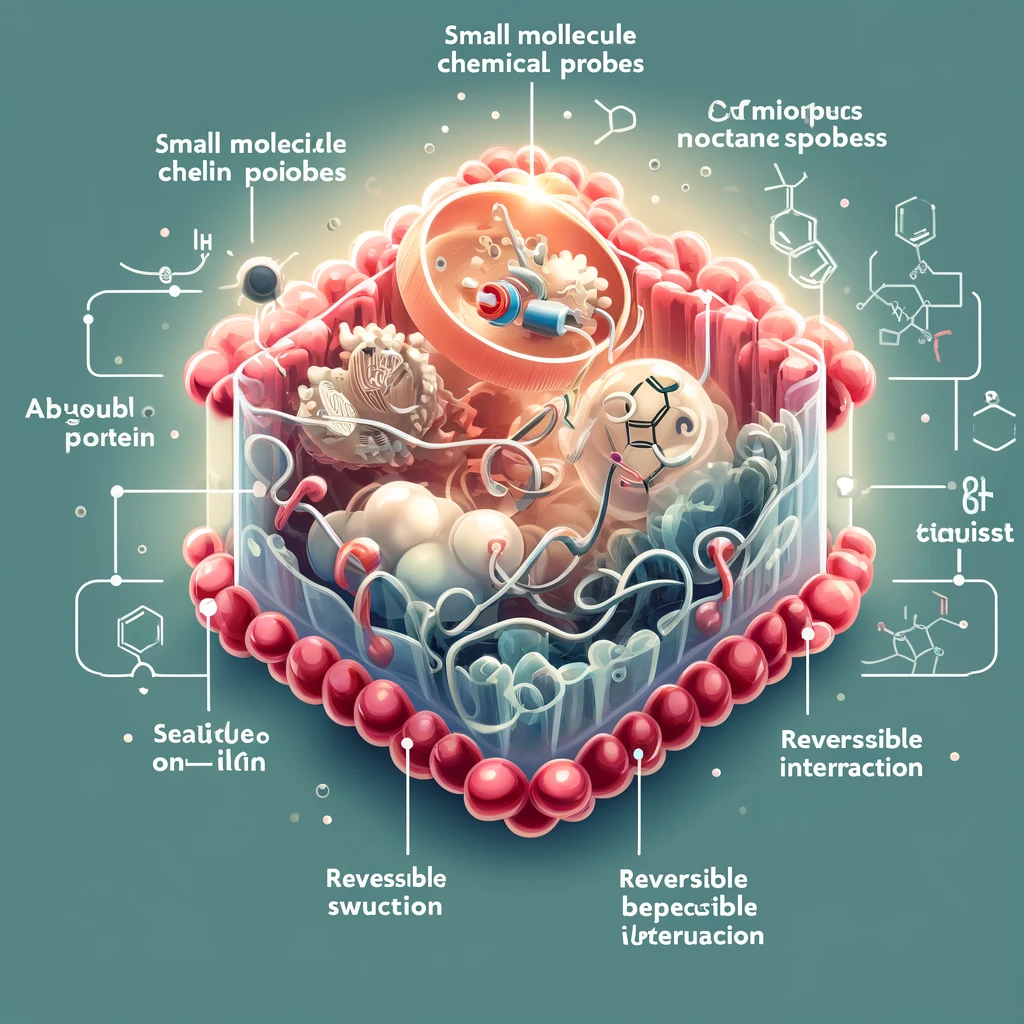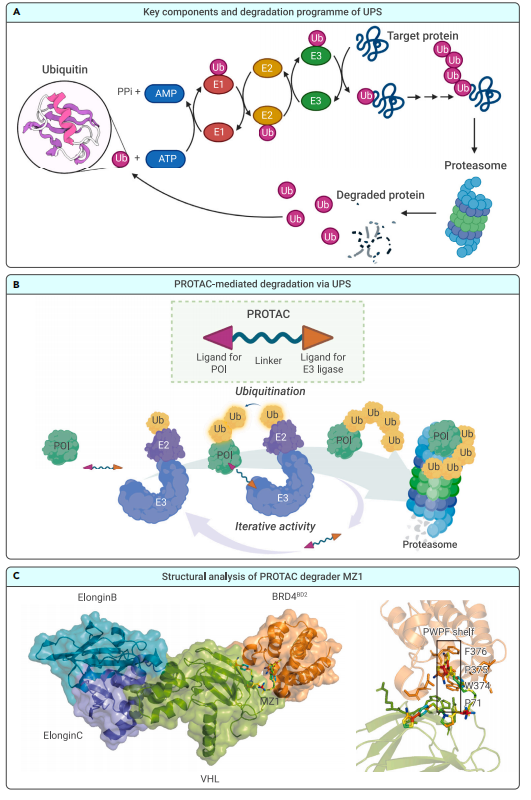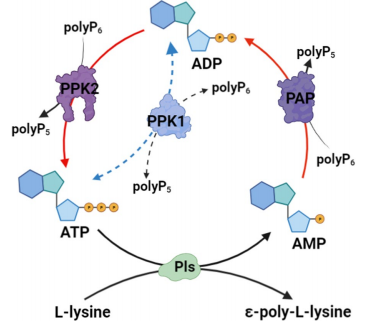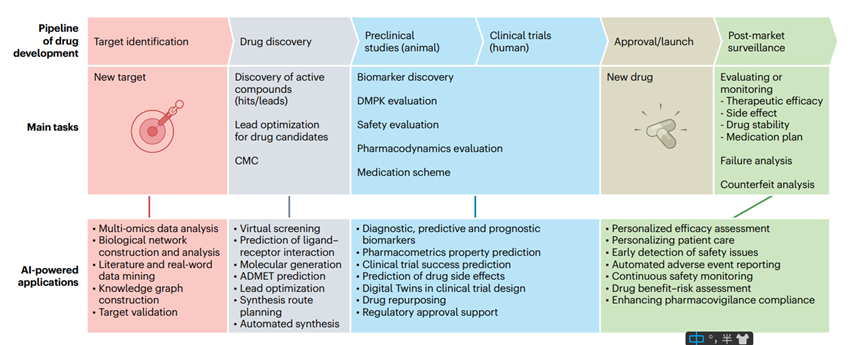Exploring the Therapeutic Benefits of Baicalin in Lung Diseases
Abstract
Baicalin, a flavonoid derived from the root of Scutellaria baicalensis Georgi, has shown significant promise in treating various lung diseases due to its diverse pharmacological properties. This article explores baicalin’s therapeutic potential, emphasizing its antioxidant, anti-inflammatory, immunomodulatory, anti-apoptotic, anticancer, and antiviral effects. Studies demonstrate baicalin’s efficacy in managing chronic obstructive pulmonary disease (COPD), asthma, pulmonary fibrosis, pulmonary hypertension, pulmonary infections, and lung cancer by modulating key signaling pathways, reducing oxidative stress, and inhibiting inflammation. While preclinical and initial clinical trials are promising, further research is essential to validate its efficacy and safety in human populations. This article underscores the importance of integrating natural compounds like baicalin into modern therapeutic practices to enhance healthcare outcomes.
Introduction
Lung diseases are a significant global health concern, affecting millions of individuals and contributing to substantial morbidity and mortality worldwide. Conditions such as chronic obstructive pulmonary disease (COPD), asthma, pulmonary fibrosis, pulmonary hypertension, and lung infections are prevalent and pose ongoing challenges to healthcare systems due to their chronic nature and the complexity of their management. The rising incidence of these diseases underscores the urgent need for effective treatments and preventive strategies.
Baicalin, a naturally occurring flavonoid compound, has garnered considerable attention in recent years for its potential therapeutic benefits in treating various lung diseases. Extracted from the root of Scutellaria baicalensis Georgi, a plant widely used in traditional Chinese medicine, baicalin and its aglycone form, baicalein, have a long history of use in herbal supplements and healthcare practices. Traditionally, these compounds have been employed for their anti-inflammatory, antioxidant, and antimicrobial properties, making them valuable components in the treatment of numerous ailments.
Modern research has begun to validate and expand upon these traditional uses, revealing baicalin’s multifaceted pharmacological effects. Studies have demonstrated that baicalin exerts significant anti-inflammatory, immunomodulatory, and antioxidant activities, which are crucial in managing inflammatory and oxidative stress-related lung conditions. Furthermore, baicalin has shown promise in inhibiting the progression of lung cancer and viral infections, including those caused by influenza and coronaviruses.
Given the increasing prevalence of lung diseases and the limitations of current therapeutic options, baicalin represents a promising natural compound with potential applications in modern medicine. This article will explore the therapeutic roles of baicalin in various lung diseases, discuss the underlying mechanisms of its action, and highlight the importance of continued research to fully understand its benefits and applications.
Understanding Baicalin
Baicalin is a naturally occurring flavonoid compound that is derived from the root of Scutellaria baicalensis Georgi, commonly known as Chinese skullcap. This plant has been used for centuries in traditional Chinese medicine to treat various ailments, including inflammatory diseases, infections, and even cancer. Baicalin is the glycoside form of baicalein, which means it is baicalein bound to a sugar molecule, enhancing its solubility and bioavailability in the human body.

The chemical structure of baicalin consists of a flavone backbone with hydroxyl groups at specific positions, contributing to its antioxidant properties. Baicalein, the aglycone form, lacks this sugar molecule but retains similar therapeutic effects. These compounds are characterized by their polyphenolic structure, which allows them to interact with multiple biological targets, thereby exerting diverse pharmacological effects.
Historically, baicalin has held significant importance in traditional medicine. It has been utilized in herbal remedies for its potent anti-inflammatory and antimicrobial activities. In ancient Chinese medical texts, preparations containing baicalin were prescribed for conditions such as respiratory infections, fever, and gastrointestinal disorders. The widespread use of baicalin in traditional medicine laid the groundwork for modern scientific investigations into its therapeutic potential.
In recent years, baicalin has gained considerable attention in the field of pharmacology. Studies have demonstrated its efficacy in treating various lung diseases, including COPD, asthma, and pulmonary fibrosis. The compound’s ability to modulate immune responses, reduce oxidative stress, and inhibit inflammatory pathways makes it a promising candidate for developing new treatments for these conditions. Additionally, baicalin’s anticancer properties have been explored, with research indicating its role in inhibiting tumor growth and metastasis.
Understanding the origins, chemical structure, and historical usage of baicalin provides valuable insights into its potential applications in modern medicine. As research continues to uncover its mechanisms of action, baicalin may become an integral component of therapeutic strategies for managing lung diseases and other health conditions.
Mechanisms of Action
Baicalin exhibits a wide array of pharmacological effects that contribute to its therapeutic potential in treating various lung diseases. These effects are primarily due to its antioxidant, anti-inflammatory, immunomodulatory, anti-apoptotic, anticancer, and antiviral properties. Understanding these mechanisms provides a comprehensive insight into how baicalin can be effectively used in medical treatments.
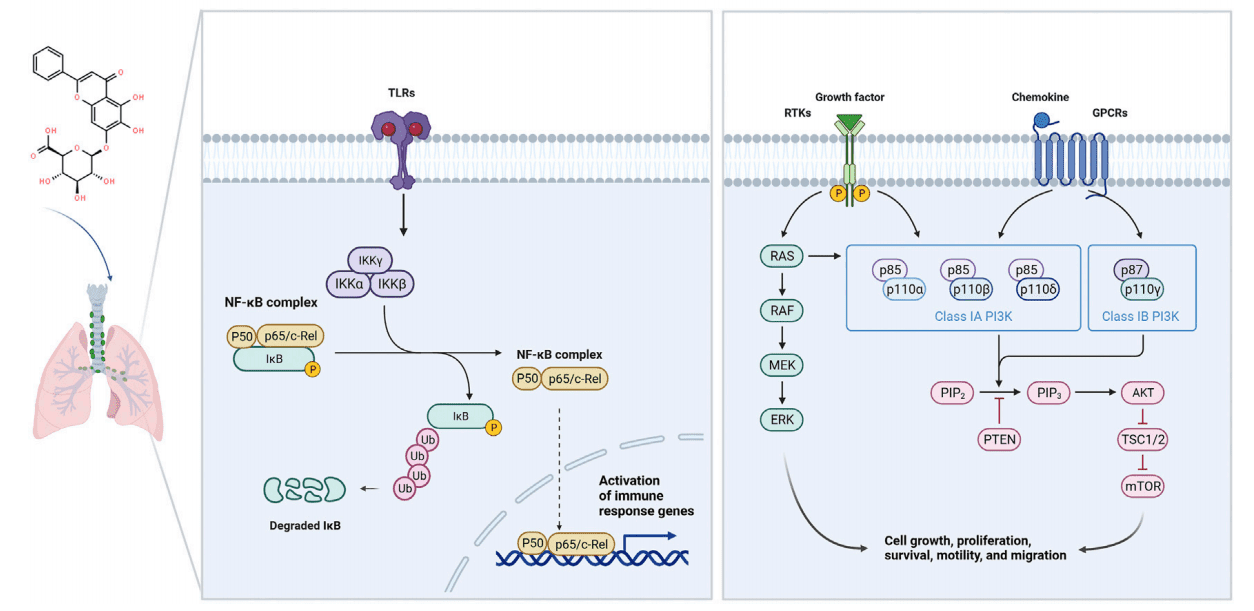
Antioxidant Properties
Baicalin’s chemical structure, rich in hydroxyl groups, allows it to scavenge free radicals and reduce oxidative stress. This antioxidant activity helps in protecting lung tissues from damage caused by reactive oxygen species (ROS), which are prevalent in chronic lung conditions like COPD and asthma.
Anti-inflammatory Properties
Baicalin significantly reduces inflammation by inhibiting the production of pro-inflammatory cytokines and chemokines. It achieves this by targeting several key signaling pathways involved in the inflammatory response, including the nuclear factor-kappa B (NF-κB) pathway. By preventing the activation of NF-κB, baicalin reduces the expression of genes responsible for inflammation, thus alleviating symptoms in inflammatory lung diseases.
Immunomodulatory Effects
Baicalin modulates the immune system by balancing pro-inflammatory and anti-inflammatory responses. It influences the activity of various immune cells, including macrophages and T cells, enhancing the body’s ability to fight infections while reducing harmful inflammatory responses. This immunomodulatory effect is particularly beneficial in diseases like asthma and pulmonary fibrosis, where immune dysregulation plays a critical role.
Anti-apoptotic Properties
Baicalin exerts protective effects on lung cells by inhibiting apoptosis, or programmed cell death. This is crucial in conditions such as acute lung injury (ALI) and acute respiratory distress syndrome (ARDS), where excessive cell death contributes to tissue damage. Baicalin achieves this by modulating apoptotic pathways, including the PI3K/AKT signaling pathway, which promotes cell survival.
Anticancer Properties
Research has shown that baicalin inhibits the proliferation, migration, and invasion of cancer cells, including lung cancer cells. It induces apoptosis and cell cycle arrest in these cells, thereby reducing tumor growth and metastasis. Baicalin’s anticancer effects are mediated through various mechanisms, including the inhibition of the mitogen-activated protein kinases (MAPKs) and the modulation of the PI3K/AKT pathway.
Antiviral Effects
Baicalin exhibits antiviral activity against several respiratory viruses, including influenza and SARS-CoV. It inhibits viral replication and reduces viral load by interfering with viral entry and replication processes. Baicalin’s antiviral properties are particularly valuable in managing viral-induced lung infections and preventing complications in chronic lung disease patients.
Interaction with Signaling Pathways
Baicalin’s therapeutic effects are largely attributed to its interaction with multiple signaling pathways. By targeting pathways such as NF-κB, PI3K/AKT, MAPKs, and Toll-like receptors (TLRs), baicalin can modulate inflammatory responses, oxidative stress, apoptosis, and immune function. This multi-targeted approach makes baicalin a versatile compound in the treatment of various lung diseases.
Baicalin in Specific Lung Diseases
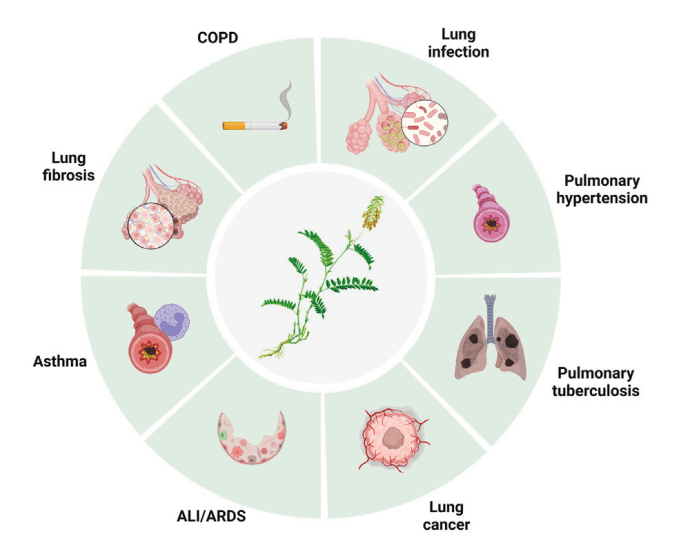
Chronic Obstructive Pulmonary Disease (COPD)
Chronic Obstructive Pulmonary Disease (COPD) is a major cause of morbidity and mortality worldwide, characterized by persistent respiratory symptoms and airflow limitation. Inflammation, oxidative stress, and protease-antiprotease imbalance are critical in the pathogenesis of COPD. Studies have shown that baicalin can significantly alleviate these symptoms. Baicalin exerts anti-inflammatory effects by inhibiting the activation of the NF-κB pathway and reducing the release of pro-inflammatory cytokines. Additionally, its antioxidant properties help reduce oxidative stress in the lungs, thereby improving lung function and reducing mucus production.
Asthma
Asthma is a chronic inflammatory disease of the airways that leads to episodes of wheezing, shortness of breath, and coughing. The pathophysiology of asthma involves chronic airway inflammation, bronchial hyperresponsiveness, and structural changes in the airway. Baicalin has been found to play a beneficial role in managing asthma by reducing airway inflammation. It modulates the Th17/Treg imbalance, reduces mucus production, and inhibits bronchial smooth muscle contraction. By targeting the NF-κB and other signaling pathways, baicalin helps to alleviate the severity of asthma symptoms and improve overall lung function.
Pulmonary Fibrosis
Pulmonary fibrosis is a progressive lung disease characterized by the scarring and stiffening of lung tissue, leading to severe breathing difficulties. It is a challenging condition to treat due to its complex pathogenesis involving inflammation, oxidative stress, and extracellular matrix deposition. Baicalin has shown promise in treating pulmonary fibrosis by modulating key signaling pathways, such as TGF-β/Smad, which are involved in fibrotic processes. It helps to balance the Th17/Treg responses and reduce myofibroblast activation and collagen deposition, thereby mitigating the progression of fibrosis and improving lung function.
Pulmonary Hypertension
Pulmonary hypertension (PH) is a condition characterized by elevated blood pressure in the pulmonary arteries, leading to right heart failure and other complications. The condition is often associated with the proliferation of pulmonary artery smooth muscle cells (PASMCs) and endothelial dysfunction. Baicalin has been found to attenuate PH by reducing hypoxia-induced pulmonary vascular remodeling and right ventricular hypertrophy. It achieves this by modulating the AKT and p38 MAPK signaling pathways, reducing inflammation, and enhancing the expression of protective factors such as endothelial nitric oxide synthase (eNOS).
Pulmonary Infections
Pulmonary infections, including pneumonia, are significant causes of morbidity and mortality, particularly among the elderly and immunocompromised individuals. Baicalin exhibits strong antimicrobial and antiviral properties, making it a valuable therapeutic agent for treating lung infections. It enhances the clearance of bacterial pathogens like Pseudomonas aeruginosa and Staphylococcus aureus from the lungs and inhibits the replication of viruses such as influenza and SARS-CoV. Baicalin’s ability to modulate the immune response and reduce inflammation further supports its role in managing pulmonary infections.
Lung Cancer
Lung cancer remains one of the leading causes of cancer-related deaths globally. Baicalin has demonstrated significant anticancer properties in various studies. It inhibits the proliferation, migration, and invasion of lung cancer cells by inducing apoptosis and cell cycle arrest. Baicalin’s anticancer effects are mediated through multiple pathways, including the suppression of the PI3K/AKT and MAPK pathways. It also enhances the effectiveness of chemotherapy and radiotherapy, making it a potential adjuvant therapy for lung cancer treatment.
Clinical Applications and Future Directions
Summary of Current Clinical Research and Trials
Baicalin has been the focus of numerous preclinical studies and some clinical trials due to its diverse pharmacological properties. Research has demonstrated its potential in treating various lung diseases, including COPD, asthma, pulmonary fibrosis, and lung cancer. Clinical trials have begun to explore baicalin’s effectiveness and safety in humans, with promising results indicating its potential as an adjunct therapy. These studies highlight baicalin’s ability to reduce inflammation, modulate immune responses, and protect against oxidative damage, thereby improving overall lung function and patient outcomes.
Potential Future Applications in Medicine and Healthcare
Given its broad spectrum of biological activities, baicalin has potential applications beyond lung diseases. Its anti-inflammatory, antioxidant, and anticancer properties suggest it could be beneficial in treating cardiovascular diseases, neurodegenerative disorders, and other chronic inflammatory conditions. Additionally, baicalin’s antiviral effects make it a promising candidate for managing viral infections, including those caused by emerging respiratory viruses. As a natural compound with a favorable safety profile, baicalin could also be integrated into dietary supplements and functional foods to promote overall health and prevent disease.
Discussion on the Need for More Human Clinical Trials
While preclinical studies and initial clinical trials have shown baicalin’s potential, more extensive human clinical trials are necessary to fully confirm its efficacy and safety. Current research predominantly relies on animal models and in vitro studies, which, while informative, cannot entirely replicate human physiology. Rigorous clinical trials involving diverse populations and standardized dosages are crucial to determine the optimal therapeutic use of baicalin. These studies should focus on various aspects, including long-term safety, potential side effects, and interactions with other medications.
Potential Challenges and Considerations for Baicalin Therapy
Despite its potential, several challenges must be addressed before baicalin can be widely adopted in clinical practice. One significant challenge is the standardization of baicalin extracts, ensuring consistent potency and purity across different formulations. Another consideration is understanding the pharmacokinetics and bioavailability of baicalin in humans, as its absorption and metabolism can vary. Additionally, potential drug interactions need thorough investigation, particularly for patients taking multiple medications. Addressing these challenges through comprehensive research and collaboration between scientists, clinicians, and regulatory bodies will be essential for the successful integration of baicalin into mainstream healthcare.
Conclusion
Baicalin has emerged as a promising natural compound with significant therapeutic potential in managing a variety of lung diseases. Its multifaceted pharmacological properties, including antioxidant, anti-inflammatory, immunomodulatory, anti-apoptotic, anticancer, and antiviral effects, make it a valuable candidate for treating conditions such as chronic obstructive pulmonary disease (COPD), asthma, pulmonary fibrosis, pulmonary hypertension, pulmonary infections, and lung cancer. Baicalin’s ability to modulate key signaling pathways and reduce oxidative stress and inflammation underpins its effectiveness in improving lung function and overall health outcomes in these diseases.
Despite the encouraging findings from preclinical studies and initial clinical trials, extensive research is still required to fully validate the efficacy and safety of baicalin in human populations. Rigorous clinical trials are essential to establish standardized dosages, understand long-term effects, and identify any potential side effects or drug interactions. Furthermore, research should continue to explore the mechanisms of action of baicalin in different disease contexts to optimize its therapeutic applications. Addressing these gaps through collaborative and interdisciplinary research efforts will be crucial in harnessing the full potential of baicalin in modern medicine.
The integration of natural compounds like baicalin into contemporary therapeutic practices represents a promising approach to enhancing healthcare. Natural compounds often offer fewer side effects compared to synthetic drugs and can provide complementary benefits in disease management. As scientific evidence supporting the efficacy of natural compounds grows, healthcare providers and researchers should consider incorporating these substances into treatment regimens. Promoting the use of baicalin and other natural compounds, backed by robust clinical evidence, can lead to more holistic and effective healthcare solutions, benefiting patients worldwide.

